If you’ve ever walked past a blooming magnolia tree and stopped in your tracks, you’re not alone. Magnolia flowers are some of the most stunning and fragrant blossoms you’ll find in American gardens. With their large, creamy petals and sweet scent, these Southern beauties have captured hearts from coast to coast. Whether you’re dreaming of a stately tree in your front yard or a compact shrub for a smaller space, magnolias offer something special for every gardener.
In this guide, we’ll walk you through everything you need to know about magnolia flowers. We’ll explore the different types available, share step-by-step planting instructions, and give you practical care tips to keep your magnolia thriving for years to come. You’ll also learn about pruning techniques, common pests to watch for, and creative ways to incorporate these gorgeous flowers into your landscape. Let’s dive into the wonderful world of magnolia flowers!
Significance & Symbolism of Magnolia
Magnolia flowers carry deep meaning that goes beyond their physical beauty. These elegant blooms have been cherished for centuries, representing some of humanity’s most treasured values. In the American South, magnolias are practically iconic, symbolizing dignity and grace. The magnolia’s symbolism makes it a meaningful addition to any garden.
Here’s what magnolia flowers represent:
- Purity and Innocence – The white petals symbolize clean beauty and noble character
- Strength and Perseverance – Magnolias are ancient flowers that have survived for millions of years
- Love and Romance – Often associated with Venus, the goddess of love and beauty
- Joy and Vitality – The cheerful blooms bring happiness wherever they grow
- Nobility and Dignity – Historically linked to aristocracy and refined taste
Understanding the symbolism behind your magnolia flowers adds an extra layer of appreciation when you watch them bloom each spring.
Types of Magnolia Flowers
Southern Magnolia
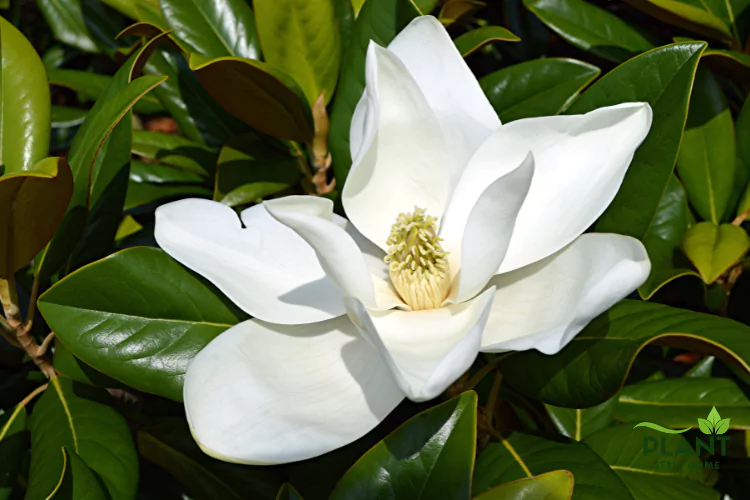
The Southern magnolia is the classic choice for traditional American landscapes. This evergreen beauty produces massive, creamy-white flowers that can measure up to 12 inches across. The fragrance of a Southern magnolia in full bloom is absolutely intoxicating. These trees are the quintessential symbol of Southern hospitality and grace.
| Attribute | Details |
|---|---|
| Origin | Southeastern United States |
| Height | 60-80 feet tall |
| Soil Type | Well-drained, slightly acidic |
| Sunlight | Full sun to partial shade |
| Water Needs | Moderate, drought-tolerant once established |
| Blooming Season | Late spring through summer |
Star Magnolia
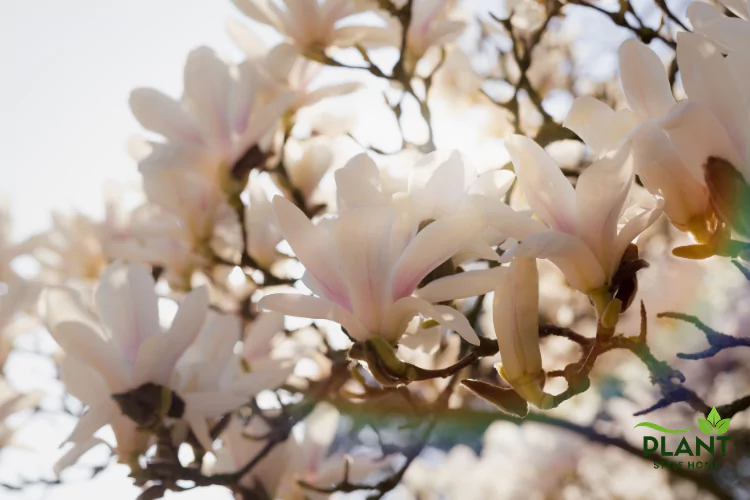
The star magnolia is perfect for gardeners who want magnolia beauty in a smaller package. This deciduous shrub produces delicate, star-shaped flowers that appear in early spring before the leaves emerge. Star magnolias are one of the first signs that winter is finally ending. The white or pink blooms create a stunning display against bare branches.
| Attribute | Details |
|---|---|
| Origin | Japan |
| Height | 15-20 feet tall |
| Soil Type | Rich, moist, well-drained soil |
| Sunlight | Full sun to partial shade |
| Water Needs | Regular watering, especially when young |
| Blooming Season | Early to mid-spring |
Saucer Magnolia
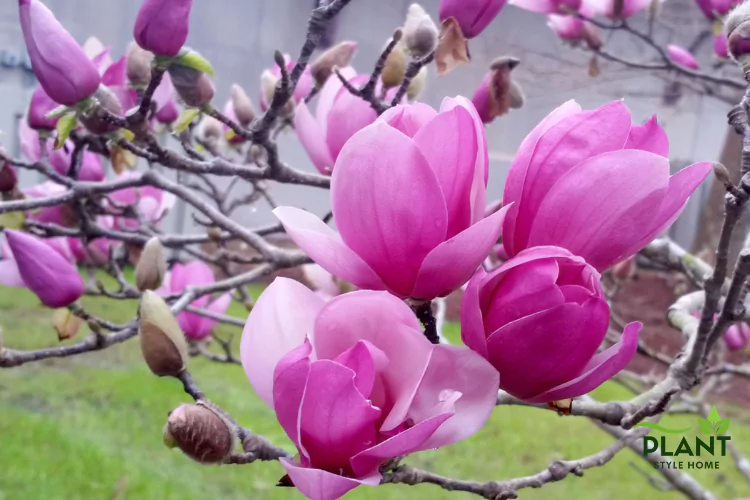
Saucer magnolias are show-stoppers with their large, cup-shaped flowers in shades of pink, purple, and white. These hybrid beauties are among the most popular magnolia flowers for American gardens. The two-toned petals look like they’ve been hand-painted by an artist. They bloom abundantly, creating a spectacular spring display.
| Attribute | Details |
|---|---|
| Origin | Hybrid (France, 1820s) |
| Height | 20-30 feet tall |
| Soil Type | Moist, well-drained, slightly acidic |
| Sunlight | Full sun to light shade |
| Water Needs | Regular watering, keep soil consistently moist |
| Blooming Season | Early to mid-spring |
Sweetbay Magnolia
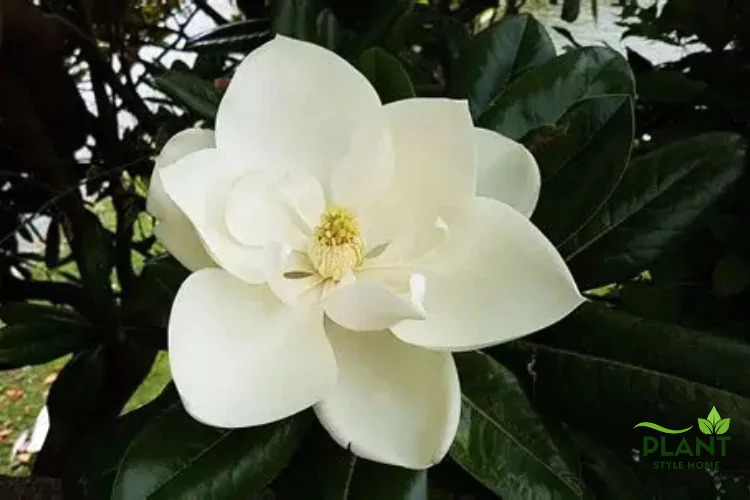
Sweetbay magnolia is a native American species that thrives in wet conditions. This semi-evergreen tree produces creamy-white flowers with a lemony fragrance. The silvery undersides of the leaves shimmer beautifully in the breeze. It’s an excellent choice for rain gardens or areas with poor drainage.
| Attribute | Details |
|---|---|
| Origin | Eastern United States |
| Height | 15-25 feet tall (can reach 50 feet in ideal conditions) |
| Soil Type | Moist to wet, acidic soil |
| Sunlight | Full sun to partial shade |
| Water Needs | High, tolerates wet conditions |
| Blooming Season | Late spring through summer |
Cucumber Tree Magnolia
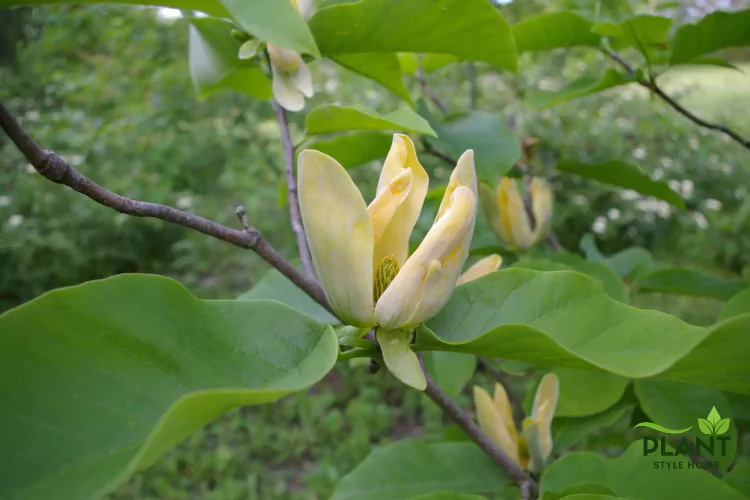
The cucumber tree magnolia gets its unusual name from the cucumber-shaped seed pods that appear after flowering. This native North American species is one of the tallest magnolias. The greenish-yellow flowers are more subtle than other magnolia varieties but still lovely. It’s an excellent shade tree with a pyramidal shape.
| Attribute | Details |
|---|---|
| Origin | Eastern United States |
| Height | 50-80 feet tall |
| Soil Type | Deep, rich, moist soil |
| Sunlight | Full sun to partial shade |
| Water Needs | Moderate to high |
| Blooming Season | Late spring |
Jane Magnolia
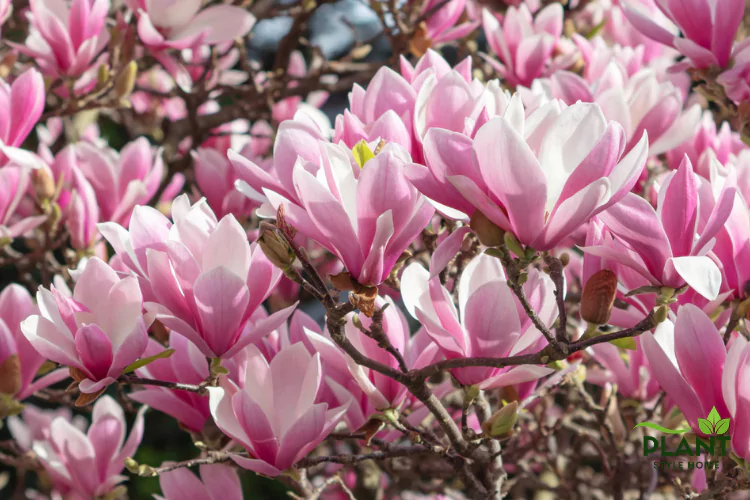
Jane magnolia is part of the “Little Girl” series of hybrid magnolias bred for cold hardiness. These compact shrubs produce stunning reddish-purple flowers that are white inside. Jane magnolias bloom later than most varieties, which helps them avoid frost damage. They’re perfect for smaller yards and urban gardens.
| Attribute | Details |
|---|---|
| Origin | United States National Arboretum hybrid |
| Height | 10-15 feet tall |
| Soil Type | Well-drained, slightly acidic |
| Sunlight | Full sun to partial shade |
| Water Needs | Moderate, regular watering |
| Blooming Season | Mid to late spring |
How to Plant & Grow Magnolia Flowers
Planting magnolia flowers successfully starts with choosing the right time and preparing your site properly. Getting the basics right means your magnolia will reward you with decades of beautiful blooms. Here’s your step-by-step guide to planting magnolia flowers:
Best Planting Time:
- Plant in early spring after the last frost
- Fall planting works well in warmer climates (zones 7-9)
- Avoid planting during hot summer months or when the ground is frozen
Step-by-Step Planting Guide:
- Choose Your Location Wisely – Select a spot with good drainage and appropriate sunlight for your magnolia variety. Remember that magnolias don’t like being moved, so this is a permanent decision.
- Test and Prepare Soil – Magnolias prefer slightly acidic soil (pH 5.5-6.5). Add sulfur to lower pH if needed, or lime to raise it. Mix in compost or aged manure to improve soil quality.
- Dig the Perfect Hole – Make the hole 2-3 times wider than the root ball but no deeper. The top of the root ball should sit slightly above ground level to prevent water from pooling around the trunk.
- Handle Roots Carefully – Gently loosen any circling roots before planting. If the root ball is wrapped in burlap, you can leave it on but remove any wire or twine from around the trunk.
- Position and Backfill – Place your magnolia in the center of the hole. Backfill with the original soil mixed with compost (about 1 part compost to 3 parts soil). Don’t add fertilizer at planting time.
- Water Thoroughly – Give your newly planted magnolia a deep soaking. Create a water ring around the base to help retain moisture.
- Apply Mulch – Spread 2-4 inches of organic mulch around the base, keeping it a few inches away from the trunk. This conserves moisture and regulates soil temperature.
- Stake If Necessary – Only stake if planting in a windy location. Remove stakes after one growing season.
Spacing Guidelines:
- Large varieties (Southern magnolia): 20-30 feet apart
- Medium varieties (Saucer magnolia): 15-20 feet apart
- Compact varieties (Star, Jane): 10-15 feet apart
Care Tips for Magnolia Flowers
Essential Magnolia Care Guide
Keeping your magnolia flowers healthy doesn’t require expert gardening skills. Follow these practical care tips and your magnolia will thrive:
Watering:
- Water deeply once or twice weekly during the first two years
- Established magnolias are somewhat drought-tolerant but prefer consistent moisture
- During hot, dry periods, water weekly with 1-2 inches of water
- Reduce watering in fall to help the tree prepare for dormancy
- Always water at the base of the tree, not on the leaves
Fertilizing:
- Feed in early spring before new growth appears
- Use a slow-release, balanced fertilizer formulated for acid-loving plants (like 10-10-10 or 12-4-8)
- Apply fertilizer around the drip line, not against the trunk
- Young trees benefit from feeding 2-3 times during the growing season
- Mature trees may only need fertilizing once yearly or every other year
- If your magnolia is blooming well and growing steadily, it may not need fertilizer at all
Pruning:
- Prune immediately after flowering to avoid cutting off next year’s blooms
- Remove dead, damaged, or crossing branches
- Keep cuts clean and avoid leaving stubs
- Minimize pruning on mature trees – magnolias don’t respond well to heavy cutting
- Less is more when it comes to pruning magnolia flowers
Pest Prevention:
- Inspect leaves regularly for signs of insects or disease
- Encourage beneficial insects by avoiding broad-spectrum pesticides
- Keep the area around your magnolia clean and free of debris
- Ensure good air circulation by not overcrowding with other plants
- Healthy magnolias rarely have serious pest problems
Seasonal Care:
- Spring: Apply fresh mulch and fertilizer; check for frost damage on early bloomers
- Summer: Water during dry spells; watch for signs of stress like wilting leaves
- Fall: Reduce watering; rake and dispose of fallen leaves to prevent fungal issues
- Winter: Protect young trees with burlap screens in harsh climates; avoid pruning
Pruning & Maintenance
Pruning magnolia flowers requires a light touch and good timing. Unlike many trees, magnolias prefer minimal pruning and can actually be harmed by over-zealous cutting. The key is to prune at the right time and for the right reasons.
When to Prune: The best time to prune magnolia flowers is immediately after they finish blooming. This timing is critical because magnolias set their flower buds for next year on new growth during summer. If you prune in fall, winter, or early spring, you’ll be cutting off next season’s flowers.
What to Prune: Focus on the three D’s – dead, diseased, and damaged wood. Remove any branches that are:
- Dead or dying
- Showing signs of disease or fungal infection
- Broken or damaged by storms
- Crossing or rubbing against other branches
- Growing inward toward the tree’s center
- Creating an unbalanced shape
How to Prune: Make clean cuts just outside the branch collar (the slight swelling where the branch meets the trunk). Never leave stubs, and never cut into the branch collar itself. Use sharp, clean pruning tools to prevent disease transmission.
For young magnolias, you can do light shaping to establish a strong structure. Remove competing leaders and encourage a single trunk for tree forms. For shrub forms like star magnolia, you can allow multiple stems to develop naturally.
Special Considerations:
- Magnolias have thin bark that’s easily damaged, so avoid using climbing spikes
- The sap can stain, so wear old clothes when pruning
- Dispose of diseased branches away from your garden
- Don’t worry if your magnolia “bleeds” sap when pruned – this is normal and won’t harm the tree
Remember, mature magnolias rarely need pruning beyond removing dead wood. If your tree looks good, leave it alone!
Common Pests & Diseases
While magnolia flowers are generally hardy, they can face a few challenges. Knowing what to look for helps you catch problems early.
Scale Insects: These tiny, armored pests attach to branches and leaves, sucking sap from the tree. You’ll notice small bumps on stems and a sticky substance on leaves below. Heavy infestations weaken the tree and attract sooty mold.
- Treatment: Spray with horticultural oil in late winter to smother overwintering scales. For active infestations, use insecticidal soap or neem oil.
Aphids: Soft-bodied aphids cluster on new growth and flower buds. They secrete honeydew, which leads to sooty mold growth. While rarely fatal, they can distort new leaves and reduce flowering.
- Treatment: Spray aphids off with a strong stream of water. For persistent problems, apply insecticidal soap or encourage natural predators like ladybugs.
Leaf Spot Diseases: Various fungal and bacterial leaf spots can affect magnolia flowers, causing brown or black spots on foliage. While unsightly, they rarely harm healthy trees.
- Prevention: Rake and destroy fallen leaves. Ensure good air circulation. Avoid overhead watering. Apply fungicides only if the problem is severe.
Powdery Mildew: This fungal disease creates a white, powdery coating on leaves, especially in humid conditions with poor air circulation. It’s more common on younger trees.
- Prevention and Treatment: Improve air circulation by proper spacing. Water at the base, not overhead. Apply sulfur-based fungicides if necessary.
Verticillium Wilt: This serious soil-borne fungal disease causes sudden wilting and death of branches. Leaves may turn yellow or brown and remain attached. Unfortunately, there’s no cure for verticillium wilt.
- Prevention: Plant magnolias in well-drained soil. Avoid areas where susceptible plants (tomatoes, potatoes, roses) were previously grown. Remove and destroy infected trees to prevent spread.
General Prevention Tips:
- Plant magnolias in optimal conditions with good drainage
- Avoid wounding the bark with lawn equipment
- Water properly – too much or too little stresses trees
- Keep mulch away from the trunk to prevent rot
- Fertilize appropriately – over-fertilizing causes soft growth susceptible to pests
- A healthy magnolia is the best defense against pests and diseases
Incorporating Magnolia Flowers into Your Garden
Magnolia flowers are incredibly versatile in landscape design. These stunning trees can serve as focal points, shade providers, or privacy screens depending on how you use them. Here are creative ways to incorporate magnolias into your outdoor space:
Specimen Tree: Plant a Southern magnolia or saucer magnolia as a stand-alone focal point in your front yard. Give it plenty of room to spread, and keep the area beneath it simple with mulch or shade-tolerant groundcovers like hostas or ferns. The tree itself is the star – it doesn’t need competition.
Privacy Screen: Use evergreen Southern magnolias as a living fence along property lines. Plant them 20-30 feet apart for full coverage as they mature. This creates a beautiful, fragrant privacy barrier that’s far more attractive than a wooden fence.
Foundation Planting: Compact varieties like star magnolia or Jane magnolia work beautifully near home foundations. Plant them where you can enjoy the spring blooms from windows. Just remember to leave enough space – even small magnolias grow larger than you might expect.
Shade Garden Anchor: Use larger magnolias to create dappled shade for woodland gardens underneath. The filtered light is perfect for shade-loving perennials, ferns, and spring bulbs. The magnolia’s blooms provide spring interest while the canopy creates summer shade.
Southern-Style Charm: Embrace traditional Southern landscaping by pairing magnolias with azaleas, camellias, and boxwood hedges. Add a bench beneath your magnolia for a classic garden room atmosphere. White gravel or brick pathways complete the elegant look.
Small Space Solutions: Don’t skip magnolias just because you have limited space. Choose dwarf varieties like Little Gem (a compact Southern magnolia) or Ann magnolia (another “Little Girl” hybrid). These work beautifully in courtyard gardens or even large containers on patios.
Wildlife Garden: Magnolia flowers attract bees, butterflies, and hummingbirds. The seed cones provide food for birds in fall. Plant your magnolia as part of a wildlife-friendly landscape with native perennials and berry-producing shrubs.
Regional Considerations:
- Southern States: Embrace evergreen Southern magnolias for year-round beauty
- Northern States: Choose cold-hardy varieties like cucumber tree or star magnolia
- Coastal Areas: Sweetbay magnolia tolerates salt spray and wet conditions
- Urban Gardens: Opt for smaller varieties that fit tighter spaces and tolerate pollution
The key to successful magnolia landscaping is choosing the right variety for your specific space and climate.
Key Takeaways
Here are the most important things to remember about growing magnolia flowers:
- Choose the right variety for your space and climate – magnolias range from 10-foot shrubs to 80-foot trees, so proper selection is crucial for long-term success.
- Plant in spring with proper soil preparation – magnolias prefer slightly acidic, well-drained soil and don’t like being transplanted, so get the location right the first time.
- Water consistently during establishment – young magnolias need regular watering for the first two years, but mature trees are relatively drought-tolerant.
- Prune minimally and only after flowering – magnolias bloom on old wood, so pruning at the wrong time removes next year’s flowers. Less is more with magnolia pruning.
- Be patient for blooms – magnolias can take 3-5 years (sometimes longer) to produce their first flowers, but the wait is absolutely worth it for decades of stunning displays.
Frequently Asked Questions
Can magnolia flowers grow in cold climates?
Yes, several magnolia varieties are cold-hardy and thrive in northern states. Star magnolia, cucumber tree magnolia, and many “Little Girl” hybrids (like Jane and Ann) can survive in zones 4-5. However, Southern magnolia is best suited for warmer climates (zones 7-9). Choose a variety rated for your specific USDA hardiness zone and plant in a protected location to shield early blooms from late frosts.
How long does it take for magnolia flowers to bloom?
Most magnolias take 3-5 years after planting to produce their first blooms, though some varieties may take up to 10 years to flower abundantly. Grafted magnolias typically bloom sooner than seed-grown trees. Patience is essential with magnolias, but once they start blooming, they’ll reward you for decades. Age, growing conditions, and variety all affect blooming time.
Do magnolia flowers need full sunlight?
Most magnolia flowers perform best in full sun (6-8 hours daily), which encourages abundant flowering. However, many varieties tolerate partial shade, especially in hot southern climates where afternoon shade prevents stress. In general, more sun equals more blooms. Avoid deep shade, which results in sparse flowering and weak growth.
How can I protect magnolia flowers from pests?
The best pest protection is maintaining tree health through proper watering, fertilizing, and site selection. Inspect your magnolia regularly for signs of scale, aphids, or leaf diseases. Encourage beneficial insects by avoiding broad-spectrum pesticides. For specific problems, use targeted treatments like horticultural oil for scale or insecticidal soap for aphids. A healthy magnolia in the right location rarely has serious pest issues.
Which magnolia variety is best for small gardens?
For limited space, choose compact varieties like star magnolia (15-20 feet), Jane magnolia (10-15 feet), or Little Gem Southern magnolia (15-20 feet). These smaller magnolias provide the beauty and fragrance of larger varieties without overwhelming your garden. Star magnolia is particularly popular for suburban yards because it stays manageable and blooms profusely even when young.
Conclusion
Magnolia flowers represent everything we love about gardening – spectacular beauty, wonderful fragrance, and timeless elegance. From the towering grandeur of Southern magnolias to the compact charm of star magnolias, there’s a perfect variety for every American garden. While these stunning trees require patience and proper care during establishment, they reward you with decades of breathtaking spring displays.
Remember that successful magnolia growing starts with choosing the right variety for your climate and space. Plant in well-drained, slightly acidic soil, water consistently during the first few years, and resist the urge to over-prune. With minimal maintenance, your magnolia will become a cherished focal point that increases in beauty year after year.
Whether you’re drawn to the symbolic meaning of magnolias or simply captivated by their enormous, fragrant blooms, these remarkable trees connect us to gardening traditions that span generations. Start planting your own magnolia today and enjoy years of fragrant blooms that will become a treasured part of your landscape legacy.